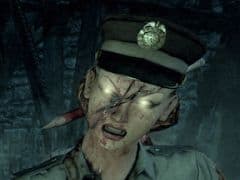Video Gamer is reader-supported. When you buy through links on our site, we may earn an affiliate commission. Prices subject to change. Learn more
A cross between the mechanics and systems of Resident Evil 4 and the tone and atmosphere of the GameCube remake of Resident Evil, Shinji Mikami’s return to horror is as spiritually close to those forbears as possible while still being legally distinct. Zwei, The Evil Within’s working title, gave some indication as to what Mikami was planning. Having played it for a couple of hours it’s become clear that he’s close to achieving his goal: namely, returning to the horror staples he helped define in 1996 with Resi, and obliterate in 2005 with Resi 4.
Our demo build had two chapters, or more accurately two chunks of chapters, vertically sliced. The first saw main character Sebastian, a cop who seems curiously unphased by the fact that the world seems to literally have gone to hell, accompanied by a strung-out doctor in a setting extremely reminiscent of the first area of Resi 4. It’s a rustic (read: the worst place on earth) village that makes Royston Vasey look inviting. Your mission is to retrieve a key. The problem is that said key is located in a dead man’s chest, in a large, dilapidated house that would make Leatherface shudder, and everyone wants to kill you.
Immediately, it’s clear that although The Evil Within looks like a sequel to Resident Evil 4 – the aspect ratio, character position, and general appearance all call to mind that masterpiece – it generally values stealth and strategy over running and gunning. Sebastian is weak, and can only sprint for about two seconds before keeling over. Ammo is scarce, and as in the Resi remake downed enemies need to be burned to stop them getting up again. Sebastian doesn’t have a lighter, however: that would be too easy. Instead he must rely on matches he finds around the world.
The relative lack of resources means you’re always assessing the situation, and acts as a stressor even when enemies aren’t around. This inherent vulnerability feeds back into the rest of the experience: players are made to tread very carefully, sneaking around, hiding in cupboards, and generally avoiding all contact with enemies. It’s a great-looking game – I was playing the PC version, where texture resolution was turned up to insane levels – but it’s also artistically well directed, dialling up the fear no end with a combination of washed-out camera work, bleak locales and a very low-key HUD.
After a little trip to the basement – which ended with me finally firing a shot, blasting someone’s head off, I removed the key from the torso. At this point the demo changed tack, introducing an unstoppable, supernatural killer, geography that made no sense at all (doors disappearing, hallways going on forever, etc) and an abattoir-based stand off between Sebastian and multiple enemies. They’re not the smartest bunch, but they’re tough and fighting them is pleasingly attritional, requiring constant positional change and a knowledge of your environment. It’s easy to get rushed.
The chapter concluded with Sebastian on the run from an unstoppable multi-limbed, erm, thing. It resembles a cross between a spider and Sadako from The Ring, and the chase scene that it’s part of is one of the tensest moments in gaming I’ve had in quite a while.
/https://oimg.videogamer.com/images/4f5e/tew3.jpg)
If this first chapter was meant to show off the mix of stealth, action and set-pieces, what followed it was pure fan-service. Stepping into a large estate, Sebastian remarks “Wait…I’ve seen that house somewhere…” That somewhere, of course, being the original Resi. As there, this mansion is both large and imposing, filled with tricks and traps (a particularly effective one being a booby-trapped lift that houses spinning blades of doom and requires some precision shooting to escape from) and a series of minor puzzles.
It’s designed to show off the game’s horror chops, and succeeds thanks to both the generally bizarre nature of the building (you insert probes into people’s brains to open a door, for reference) and the fact you’re being stalked by that same ghostly killer from before. It’s game over should he touch you – shooting only warps him closer – and there is a genuine sense of panic as you turn and flee, hiding under beds and in wardrobes.
So far The Evil Within is looking good. Its classic horror iconography and concepts isn’t anything new, and Sebastian may be curiously charisma-free, but the mixture of genuine player weakness and top-drawer graphic and art direction gives it an appeal that’s hard to deny. Another haunted house from Mikami, then, but so far a well-constructed one. The real task now is to keep that momentum going. Resident Evil 4’s genius isn’t just found in one particular thing , but a large part of it was its pacing. But that game had natural gears it could go through, thanks to the focus on action. The Evil Within can’t quite do this, and so it’s going to be interesting to see what Mikami does. He’s one of the great directors, but this may be one of his biggest tests yet.
